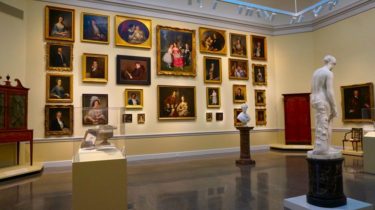Next Year , Baltimore Museum Of Art Will Buy Only Works By Ladies

Venture into one of the country’s top craftsmanship exhibition halls, and the greater part of the works you’ll see were made by men.
The Baltimore Museum of Art has chosen to make a striking advance to address that irregularity: one year from now, the historical center will just buy works made by female-recognizing craftsmen.
“This how you raise awareness and shift the identity of an institution,” exhibition hall chief Christopher Bedford revealed to The Baltimore Sun. “You don’t just purchase one painting by a female artist of color and hang it on the wall next to a painting by Mark Rothko. To rectify centuries of imbalance, you have to do something radical.”
The approach will just apply to works obtained by the historical center, not endowments. The quantity of works acquired by the historical center every year differs, and works are purchased on a moving premise.
The move is a piece of a bigger activity propelled in October called 2020 Vision, a progression of 22 shows at the historical center commending female-distinguishing specialists.
The activity incorporates 13 independent displays and seven topical shows, with all the more being arranged. One year from now denotes a century since ladies were ensured the privilege to cast a ballot in the United States, with the endorsement of the nineteenth Amendment.
The Baltimore Museum of Art has 95,000 works, including the world’s biggest assortment of works by Henri Matisse.
Its assortments incorporate 3,800 works by ladies craftsmen and architects – only 4% of its property.
A picture by Sarah Miriam Peale was given to the exhibition hall in 1916, two years after the gallery’s establishing, turning into the first work in quite a while assortment by a female craftsman. In the course of the most recent quite a few years, the exhibition hall has included many significant works by ladies, and its assortment incorporates works by Mary Cassatt, Cindy Sherman and Amy Sherald, known for her representation of Michelle Obama.
A 2019 investigation of 18 significant U.S. craftsmanship galleries found that 87% of craftsmen in their assortments are men, and 85% of the specialists are white. Another concentrate not long ago found that up to 10% of craftsmanship exhibitions don’t have a solitary lady among the specialists they speak to.
The BMA isn’t the only one in attempting to address this longstanding sexual orientation unevenness. The National Museum of Women in the Arts in Washington has 5,500 items in its assortments and presents 10 displays highlighting ladies craftsmen every year.
BMA boss guardian Asma Naeem disclosed to The Washington Post that the 2020 program is an exertion at “re-correcting the canon.”
“The challenges are systemic and widespread, because many of the works in local donors, local patrons’ collections are traditionally made by male artists,” they said. “There are these various subtle but consistent, pervasive markers of what is considered creative achievement, and we are trying to reset all of those markers.”
John Williamson was born and raised in the Bronx, New York. He was a bookseller before shifting to reporter. He lives in New York City and is tall for no reason. He contributes in Digest Express as an editor.
Disclaimer: The views, suggestions, and opinions expressed here are the sole responsibility of the experts. No journalist was involved in the writing and production of this article.
